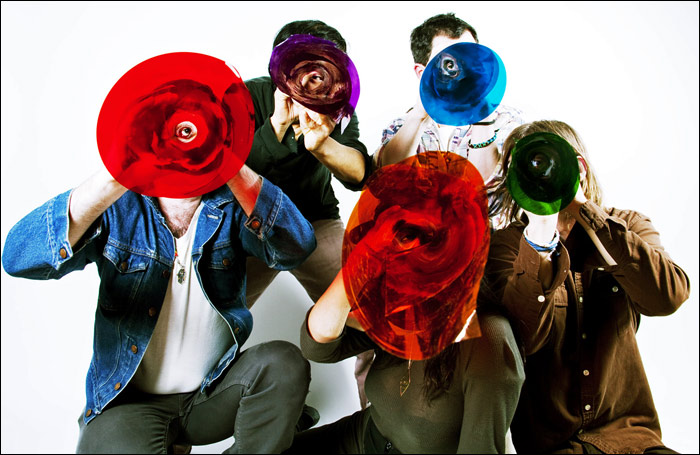
World Clique
by Kevin J. Elliott
The transformation of Gang Gang Dance from impenetrable art-rock ensemble to unwieldy psychedelic dance outfit has been one of music’s most exciting progressions over the past decade. When the group first began in 2001, they were tethered to the haute Manhattan gallery scene, playing a discombobulated primal jam as witnessed on their earliest recordings. Those records contained a mysteriously intriguing artistic vision, bubbling over with quirky aesthetics, but they were never something that would play outside of the group’s tight-knit circle of pranksters. While their avant concoctions of whizzing synthesizers, worldly rhythms and freak-folk shadows were always dramatically arresting in the live setting, they never managed to translate over to tape. It was as if the apparitions found in their wildly improvised stage show couldn’t be held down magnetically.
The eureka moment for Gang Gang Dance came with 2008’s St. Dymphna. While if you had been following along from their humble beginnings the album was the most natural of transitions, for most, it was the first glimpse of a band who could magically weave dancefloors with interstellar road maps, fairy tales with ancient ritual, and pop music with genres like house, grime and trances as disparate from the radio as they come. That sleight of hand continues on Eye Contact, the band’s recent full-length, with an even more profound effect. Gang Gang Dance’s biggest strength comes in their unwavering miscegenation of all sound under the sun, then spitting squarely in the face of convention. It’s a dance record as much as it is a hip-hop record as much as it is a psychedelic rock record; never is there a moment in the fluidity of Eye Contact (the album never takes a breath or pauses to wipe the sweat) where Gang Gang Dance can be specifically pegged, or for that matter, wholly understood. That defiance shows in bold statements like releasing the epic 10-minute “Glass Jar” as the album’s first single, or by twisting a rhythm-led live jam like “Mindkilla” into a feral disco rave-out. Even when you think they’re having a laugh, as on the quiet storm R&B of “Romance Layers,” it’s easy to sense that in the recording of Eye Contact diversion was what fit best. Above it all, the alien coo of Lizzi Bougatsos rapturously embraces a wanderlust that takes her across continents and traipsing through tropical climes, desert landscapes, jungle huts and subway tunnels like a bedouin without a comfortable home. She’s perhaps the only glue that keeps Eye Contact’s myriad of color and sound together as one cohesive statement, and it’s a mammoth statement at that.
I recently caught up with Bougatsos via e-mail before the band left for their European tour in support of Eye Contact.
I think it’s been almost two years since I’ve seen you play live in Columbus, but even back then you were playing many of the songs from Eye Contact. Is that how the album came to be, out of live jams and performances?
Lizzi Bougatsos: No, we went to the desert to write specifically, so the songs were born there. 29 Palms near Joshua Tree to be exact.
Eye Contact is a nice continuation of St. Dymphna in that it’s even more upfront than the last album. Are we to take the title of the record literally?
LB: Yes, there are many ways to look at the title, but we made a conscious effort to have a more direct relationship with the audience.
Was there a moment when you consciously made sure to add even more elements of pop to Eye Contact?
LB: No, we never really set out to make a more conscious sound. We let the sound find itself.
A lasting quality of your records is how they are usually one long flowing piece, and I think that’s something you established early on. Eye Contact is a great combination of that improvisation and more structured pop songs. How do you all sit down and plan on the path of a record?
LB: Since the songs are so diversely different, we decided that the interludes were nice breaks in between, although there is a flow.
“Romance Layers” is the point on the album that will likely take listeners aback. Not that it doesn’t fit, but it’s almost an R&B ballad of sorts and not something you think you’ll hear in the course of the record. How did that song come about?
LB: Listening to a lot of J Dilla.
Knowing you’re flying to China this week, surely that country and culture has an influence over the music. What exactly are you doing in China and what do you take from that country that your filter into your music?
LB: I was playing a show with my other band, IUD. The performance was titled Bluntforce Drama. It was a collaboration with the director of ODDSAC (the Animal Collective film from 2010), Danny Perez. I haven't really listened to much Chinese music in the past. “Chinese High” is more about living in Chinatown, NYC.
Are the lyrics important, because it feels like now more than ever it’s become even harder to decipher what you are saying?
LB: They are always important, but I tend to disagree on that one.
So now, when you start touring, are you and the band playing an entirely new set of songs, like the last tour, or are you somewhat obliged to play Eye Contact for people who have yet to see you live?
LB: We play an entirely new set every show we play, yet this time we are trying to include some songs from the record.
